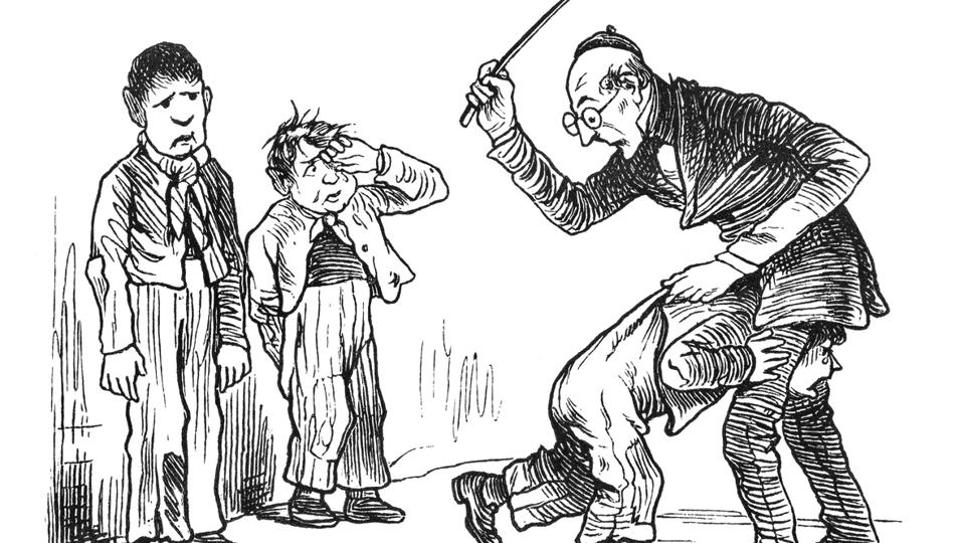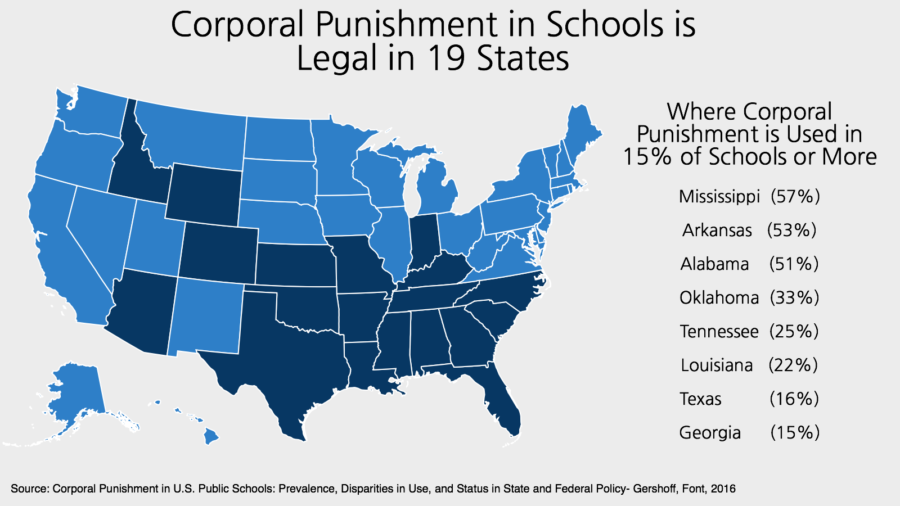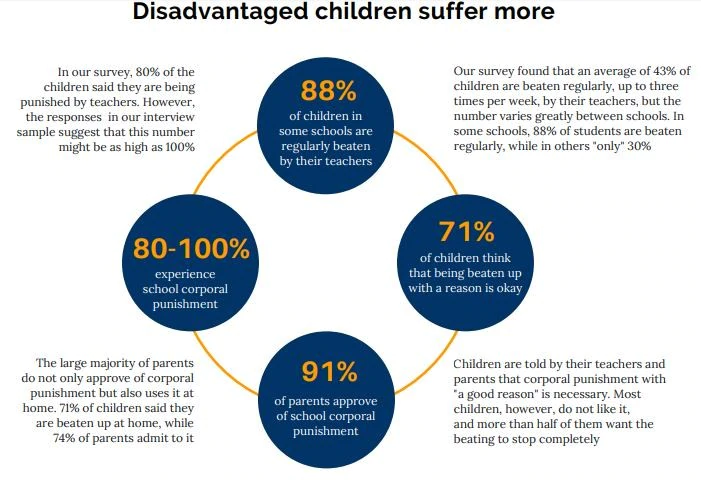Categories(658 Blogs)
Select Category
Watch Right Now
Teacher App - Class
Schedule & Attendance Management App
Parent App from Edsys

Best School Bus Tracking System

Cashless School - For Smart Schools of Tomorrow


Corporal Punishment In Schools – Definition & Consequences

Please allow us to start by explaining what corporal punishment in schools environment means. Any kind of punishment in which force is used to inflict pain, discomfort any type of distress to the student is called corporal punishment.
This could be physical or emotional ache caused, however light. It’s petrifying for any parents who love their kids.
We do realize that some or, most of you are believers that your child does not go through corporal punishments in their school.
Well, the light slap or a pinch that you may feel harmless is considered corporal punishment.
No matter how innocuous the punishment is, it is corporal punishment if the intent was to hurt the child.
Also, as we mentioned in the beginning, causing emotional discomfort is also corporal punishment.
This includes any punishment that causes your child embarrassment in front of their peers or scares them.
Corporal punishment in Schools
To explain about corporal punishment in schools, know that 2 out of 3 children that go to school are victims of corporal punishment.
This was published in 2007 in a survey report by Ministry of Women and Child Development.
We need no survey to tell us this, anyone who studied in the USA at least for a short amount of time period can vouch for this information.
Corporal punishment is a standard tool used for behavior management in children in both government and private schools alike.
In the USA, 19 states still justify corporal punishment to mold students in a better way.
If statistics are shown then almost 160000 students go through this evil every year succumbing to depression or bullying fellow mates.
Corporal punishment is not a practice seen only in US public schools. This is a global issue in almost all schools.
There are rules in multiple countries against corporal punishment; however, the lack of monitoring structures makes it difficult to track and take action against the ones involved.
Does Corporal Punishment actually Work?
We know that there is a for and against every topic and this is definitely a topic you would want to discuss extensively.
We want to understand if the corporal punishment is actually of any help to children after all the humiliation, they go through with it.
Many people are advocates of corporal punishment in schools. Corporal punishment is the go-to corrective method in schools since its inexpensive.
They consider that this is the only way to get children to listen to the elders sometimes.
Oh, we get it. All the times your child got into your nerve flashing through your mind? We know that’s not a great picture. So, obviously, corporal punishment seems like the best option to get a child to act obediently.
Then there are those who are against the very idea of corporal punishment in schools.
There is a large number of people who believe that children can be taught well with no violence in the picture. Love and Care are what they resort to, to teach children valuable life lessons.
There are multiple global organizations that are working on researches to understand the impact corporal punishment in school leaves on children.
Let’s have a look-see at the Power of Corporal Punishment on a Child and its Repercussions.
- Children often fear teachers who practice corporal punishment in school. However, this is an unhealthy rapport to maintain with the teacher. Children are more inclined to listen to teachers they admire and respect than the teachers they fear and dislike.
- Corporal punishment in school is commonly used to attain swift resolution to a child’s obedience issue, and there is no doubt in the fact that a child is most likely to amend their behavior for fear of pain. However, out of sight, out of mind. These amends are soon history when the teacher is no longer in the vicinity.
- Corporal punishment in school also makes children submissive to abuse. Children being in an environment of corporal punishment at an early age are more likely to think that abuse is a part of life. We definitely do not want our children to think of the society as an abusive group and succumb to the pressure without even trying.
- It is noticed that more often than not, a teacher uses corporal punishment as an outburst to their personal life and its issues. There have been issues where teachers use corporal punishment in school as a means to let out frustration in their personal life. This affects children in more ways than we could think of.
- It is seen that children that go through corporal punishment in school not only perform poorly in academics but also have low self-esteem.
- Corporal punishment makes the child self-doubt themselves, and this plays a significant role in how the child’s character is built as they grow up.
- Also, it is not uncommon for corporal punishment in school to escalate over time. A mild smack initially escalates to spanking as time goes by. There have been multiple reports of children made to kneel under the hot sun and their hair being pulled out, all for an issue as small as errors in homework or students chatting in class. The degree of humiliation and distress a child feels increases with the degree of corporal punishment.
- Violence breeds violence. Corporal punishment in school inflicts the idea that violence is the right path to correction into a child. Children that faced corporal punishment in school are more often seen implementing this in their personal life as a correction method.
- Studies have shown that the chances of children subjected to corporal punishment being more violent adults when they grow up are higher when compared to children that were not subjected to corporal punishment.
- Children also have difficulties in understanding why teachers are not being punished for physically abusing them. This sets a wrong example for children. This makes primary reasons why children get the idea that adults can get away with anything, even wrongdoings. This is precisely the reason they grow up to be abusers themselves since they consider that they could get away with it now that they are adults now.
- The chances of children that go through physical abuse turning out to be bullies and display other anti-social behaviors are higher than others.
- It is also seen that children who were a victim of extensive corporal punishment in school grow up to be abusers and continue to abuse their children and spouses.
- Corporal punishment in school will most definitely harm the child’s physiological health considering the emotional damage it causes. Researches show that children are known to suppress their anger, sorrow, and pain, and this acts as a piled-up pressure as they grow up.
- It is also seen that children often display signs of deep hurt in their behavior; however, this goes unnoticed often times than not. This only increases their ideology that violence is the right choice of corrective measure.
- We see how the advantages are minimal when compared to the harm corporal punishment in school causes to a child. This is precisely why it is frowned upon and banned in most countries. There are also constant awareness programs conducted to help teachers and parents understand the repercussions of corporal punishment in school and home.
- With this, we come to the next topic of how the attitude towards corporal punishment in school can be changed. It is known now that corporal punishment in school does more damage to the child’s emotional growth than good.
So, how can we help in ensuring that corporal punishment stays out the window and not in the child’s life? Well, we are glad you asked.
According to the Survey Report by India today, 80 to 100 percent of students experience corporate punishments in schools
Corporal Punishment in schools – how can we change it?
- It is crucial to have a monitoring plan to ensure corporal punishment is not practiced in schools. Teachers, Principal of the school and other staff members have to work as a team to ensure that such incidents do not go unnoticed.
- Parents also play a significant part in the monitoring plan. Parents need to ensure that corporal punishment is not practiced at home so that the child understands that corporal punishment is not the right method of correction. This opens a portal of discussion to children so that they can share their discomfort about corporal punishment practiced in school. We need to understand the fact that all children may not be comfortable sharing complaints about their teachers to school management. It is the responsibility of all adults in their life to ensure that such issues do not go unnoticed and hence, parents working along with the school authority is a critical aspect to ensure this.
- Teachers need to be trained with alternate coaching and corrective methods. We know kids. They are mischievous and will definitely end up doing something that should not have been done. Without an alternative to corporal punishment, there is no way a teacher can ensure that children do not repeat them again.
- In fact, it is even important for teachers to understand the emotional impact of corporal punishment in children. Having insight on this will help teachers understand a child’s psychology better, this will, in turn, ensure that teachers stick to the plan of No Corporal punishment in school.
- Parents and children having an open discussion with the school Principal or other school faculties will also help the school in understanding if the policies are in place. Considering the fact that there is no definitive monitoring method to measure and understand if teachers are sticking to the no corporal punishment in school rule, such slightly unorthodox methods need to be kept in practice. This will help the management monitor the teacher’s behavior in classes.
- The government needs to ensure that strict laws are in place against corporal punishment in school in all states. This will inflict the awareness in teachers that continual practice of corporal punishment in school would lead them to face severe law and order causalities. Also, explaining about student rights to teachers will ensure that the corporal punishment is kept at bay.
- Other private pieces of training to teachers on sensitivity and alternative corrective measures can also be helpful for teachers.
Alternative corrective measures
We have curated a bunch of other corrective measures that teachers and parents could follow instead of corporal punishment.
If done right, these methods will ensure to have a positive impact on a child over time without the other emotional distress a child would go through when corporal punishment is practiced.
Negative consequences – Negative consequences are when the child endures any kind of negative repercussions for their action or behavior.
This will help the child understand that their teacher is punishing them minus the distress they go through in corporal punishment.
Time out – This is a popularly used correction method by many teachers and parents alike as an alternative for corporal punishment.
This requires the misbehaving child to stay in the corner of the room, away from all the friends, toys and any other source of entertainment.
This idle period provides the child with ample time to think of the action/s that leads to the time out.
Also, missing the fun and games will cross their mind the next time the child thinks of making a ruckus again. That should teach them a lesson.
For Time out to be an effective positive re-enforcement, teachers and parents need to ensure that there is quality Time in for the child to miss the entertainment during Time Out. Failing which, the activity miscarries its purpose.
Also, there has to be an effective Time out area for the task to be successfully fulfilled.
For toddlers or children who are most likely not to sit still, a Time out room would be ideal. Else, a corner of the room or the bottom of a flight of stairs is effective as the child does not have a source of entertainment in the area and is forced to stay idle.
Understand Behavior that caused Time out
All behaviors may necessarily not call for a Time Out in the first instance.
An IF statement could come to play in many situations. “If you keep throwing the pencils down, you are going into Time out.”
This statement has to be followed with Time out if the child continues the behavior.
Multiple warnings only make the child doubt the credibility of the warning. Crucial behaviors that require immediate change will call for an immediate Time out.
Children need to understand what behavior calls for immediate Time out and what doesn’t.
This will help them in understanding what behavior of theirs has to be changed immediately and what’s them just being naughty.
Considering Time out as the first option for all negative behaviors wouldn’t make the child understand what crucial changes need to be bought in immediately.
Also, they are kids. They will be naughty. All children will end up in infinite Time out if they are placed in Time out for every mistake they do.
Consider Resistance – The child resisting Time out is a common possibility. They may not be willing to go to time out or may just simply not want to stay in time out for long.
Teachers are usually advised to warn the child of additional consequence should they not abide by the Time out rules. The IF rule comes in handy here too.
“If you do not stay in Time out, you will not be allowed to play time for the next two days.” The thought that they may lose their play time for a whole of 2 days will urge them to stay in the Time out.
- It is important to ensure that the larger consequence is followed out so that the child knows to correct their behavior. Failing to follow through the larger consequence, the child will lose faith in the process of Time out and will no longer comply with the Time out rules.
- Following through the larger consequence, however, will ensure that the child knows that there is an impending larger consequence any time they do not follow through Time out, and this will encourage them to improve their behavior better.
Effective Consequences – Consequences have to be consistent for a child to understand the importance of it. Only then will the punishments prove to be effective.
For instance, if a child gets into a fight with their friend five times, they need to face the consequences 5 times. Three consequences against five fights will not teach them the right lesson.
Positive Consequences –Now that we know what punishments like Time out do let’s look at some methods of positive consequences. Showing children their positive qualities is as important as changing their negative qualities.
Also Read: 13 Tips to Tackle Cyber Bullying among Students
Also, a child may have improved their behavior and inculcated a positive habit as a result of Negative consequences, and this needs to be rewarded. Only then will a child understand the benefits of improving themselves.
Positive attention – It is important to ensure that the child receives enough positive attention when they accomplish a task or display positive behavior.
Failing to exhibit positive attention on the kid when they display a positive trait will not show the child that what they just did was a good deed. Good and Bad will only get imprinted in their brain when an adult displays an emotion associated with their behavior.
Praise – This is something that works well on kids of all age, and we know, on adults too.
A simple “It’s really nice of you to help your friend with it,” will go a long way with kids, especially when the praise comes from their beloved teacher.
Rewards – A tangible reward for good behavior will be a constant reminder of the positive consequence they faced over positive behavior.
A tangible reward does not have to be pricey or very materialistic. It could be as simple as a star on the book from a teacher or a toffee for them to enjoy during lunch.
Teaching New Skills – One of the major reason children throw temper tantrum is that they do not know how to perform a certain task.
Helping them learn a better way to function every day will solve a lot of problems they have and hence eliminating the need to have a negative or positive consequence.
Natural Consequences – It’s okay if the child eats one too many chocolates in spite of you warning them not to.
You know the child is most likely to have a stomach ache later, but the child does not. It is sometimes best to let nature do its thing and teach children a thing or two.
By falling sick once and going through the pain, they remember that you know better in most situations.
Please understand that we are not advocators of not taking care of a child on purpose.
However, given the circumstance, such small cough, cold or stomach ache they get from not listening to you will work wonders when compared to you initiating negative consequences or even corporal punishment.
Difficulties of implementing Alternate corrective Measures
These ideas are tough to follow through. We do understand that they are easier said than done considering various other factors at play.
Crowded Classroom – A classroom is filled with children. It is close to impossible for a teacher to pay attention to individual students and reinforce all these methods all day long.
Also, the fact that many private schools overfill the classrooms makes it extra difficult for teachers to pay attention to each child.
While there is no practical solution to the issue, there are some workarounds that could be performed for the betterment of the situation:
- Appoint more than one teacher for a single classroom in primary classes. This will help divide the attention, and this will help teachers to devote more time to each child.
- Have class monitors as children grow. Teachers can interact with this monitor to understand the difficulties children are facing.
- Ensure to show at least one positive and negative consequence in a classroom every day.
Different teachers for different subject
Having a single teacher trained on these alternative methods for corporal punishment would not be effective considering there are different teachers for different subjects in all schools. 1 or 2 teachers following positive and negative consequences and the others still following corporal punishment would only send mixed signals to children. It is even not capable of resolving the issue at hand either.
- The school management has to ensure that all facilitators are trained on and implement the alternative behavior improvement programs at classes and do not resort to corporal punishment in school.
- Children need to have an open line to communicate about a fall out to ensure that action is taken against these teachers. This will help in ensuring that teachers are aware of the impending consequences they face should they continue to practice corporal punishment in school.
Cultural differences
Diversity is not an alien topic in the classroom. There are children from different families, states and even countries in the same classroom. It is close to impossible for a teacher to learn each child’s background and understand what is offensive and what is not to each child. There could be instances where a child could be more hurt than you intended to when corrective action is applied.
Wrapping up
The best and probably the only option against the corporal punishment is to explain the intent to the child and ensure that you clear things out with them. You may also include their parents in this discussion to better understand the child’s perception and to better explain your ideology.
Recent Blogs
Our Educational Services
Popular Blogs
Subscribe

SUBSCRIBE TO OUR NEWSLETTER
Sign Up and Recieve the Latest News
Don’t Worry, We Don’t SpamExplore Our Extensive Researched Educational App Directory
Visit Now





















